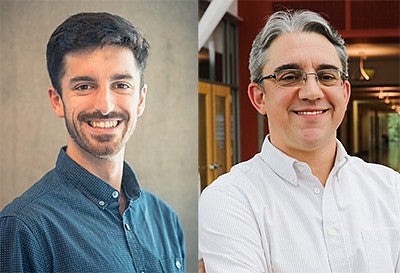The class in 110 Willamette is over, but the students are in no hurry to leave. They cluster around laptops discussing the finer points of solar versus hydroelectric power.
In this new course, titled Techno-Economic Analysis for Decarbonization, chemistry and business majors explore what it would take for the U.S. to achieve net-zero greenhouse gas emissions by 2050. Like the students, and the two faculty members teaching the class, CH 610 offers a potent combination of science and business.
“Ultimately, you want to build a community of people on campus talking and thinking about these things,” said senior instructor Joshua Skov. “It’s also good to be able to share tangible optimism. The students are excited and engaged. Above all, the message we want to convey is that there’s hope for us to meet these aggressive goals to address climate change and tackle it head-on.”
Skov is academic director and industry mentor for the Center for Sustainable Business Practices in the Lundquist College of Business. He’s also been a sustainability consultant for businesses and government organizations for more than 20 years.
The spring course focuses on four sectors that contribute most of the greenhouse gas emissions caused by humans: electricity, heating, transportation and manufacturing. Students examine financial, technical and policy barriers that stand in the way of decarbonization, which refers to reducing the share of energy produced from fossil fuels. And they analyze the potential of green alternatives to compete in the marketplace.
The business students got a little scared when they saw a periodic table of elements, Skov said. And the chemistry majors were initially uncomfortable talking about the blended cost of capital. But Skov and his collaborator Paul Kempler work to bridge the gap.
“As far as the disciplines may be apart, students with both majors are supposed to be able to use numbers and be OK with it,” said Kempler, a research assistant professor in the Department of Chemistry and Biochemistry in the College of Arts and Sciences.
“I’ve seen a lot of chemistry ideas for decarbonization, some clever and some foolish,” he said. “In most cases, you can tease that apart with some financial calculations. I don’t have any finance training, but Josh has decades of experience. I think we’ve had as much fun planning the course as we’re having teaching it.”
Kempler is associate director of the UO’s Oregon Center for Electrochemistry, where students and faculty members research how energy is generated, stored and transported. The center started in 2019 and is supported by a $5 million gift from Gordon and Betty Moore. Gordon Moore was a co-founder of Intel Corporation. Many of the center’s graduates go on to careers in emerging decarbonization industries.

This new class encourages students to take a more holistic view, Kempler said. That broadened perspective will help them create solutions that are not only innovative but economical.
UO graduate student Emma Wagstaff begins a paid internship this summer with Electra, a company in Boulder, Colorado, developing greener methods for steel production, an industry responsible for approximately 8 percent of global carbon dioxide emissions.
The internship is part of her master’s degree in electrochemistry. If her experience is like most other graduates from the program, her work with Electra will continue after the internship ends.
“The decarbonization industry is so multifaceted,” Wagstaff said. “The coolest thing about this course for me is learning business concepts. That makes it the perfect fit for all these new approaches that we need. I was just taking chemistry classes before this. Getting to know people outside the chemistry program has been really exciting.”
Learning more about the business side will help with her career, Wagstaff added. For example, cost modeling tools could be helpful in making engineering decisions. It’s also useful, Wagstaff added, to learn about different decarbonization industries.
Throughout the course, students evaluate solutions such as rooftop solar panels, batteries and hydrogen-produced ammonia. They study the revenue structures that support greenhouse gas contributors and create their own technical and financial models.
Kempler and Skov met through activities sponsored by the UO’s Environment Initiative, which provided seed funding for the course. Skov had offered a course on clean energy finance, and Kempler had been interested in teaching a class that would add technoeconomic analysis to the electrochemistry curriculum.
So they joined forces, hoping their mixture of chemistry, business, pragmatism and innovation will offer a foundation in financial and technological literacy, applied in the context of decarbonization. All that, they said, plus a healthy dose of optimism.
—By Ed Dorsch, University Communication
—Top photo: Students examine projects like wind and solar power as ways to produce clean energy


